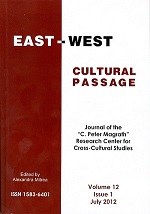World-Creation Through Music: Tolkien's 'Ainulindalë', in The Silmarillion (1977)
World-Creation Through Music: Tolkien's 'Ainulindalë', in The Silmarillion (1977)
Author(s): Sorin UngureanSubject(s): Literary Texts
Published by: Editura Universitatii LUCIAN BLAGA din Sibiu
Keywords: Ainulindalë; Ainur; cosmogony/creation myth; Eru/Ilúvatar; Manwë; Melkor; mythopoeia; The Silmarillion; “themes of music”; (willing) suspension of disbelief
Summary/Abstract: Among the story-tellers who set their narratives in worlds other than this, J. R. R. Tolkien (1892–1973) stands out owing to the far-reaching, complex plenitude of his creation: awe-inspiring peoples with cultures and languages, lore and wars stretching over ages, rendered in masterful accounts of “the times of old.” It is at the very beginning of The Silmarillion that we learn how Ëa, the physical world, was made: with the music of the Ainur (in Quenya: Ainulindalë). Reputedly influenced by the Finnish Kalevala, as well as Norse, Anglo-Saxon, Celtic and Mediterranean mythology, Tolkien imagined a world genesis that is unique among cosmogonies: the world comes forth through the music made by angel-like Ainur, according to themes proposed by the supreme entity of all existence, Ilúvatar. But soon, the most powerful Ainu, Melkor, disobeys and discords, and thus history starts unfolding... Tolkien's fictional-world genesis differs significantly from other fantasy writers', and the purpose of this essay is to interpret its design.
Journal: East-West Cultural Passage
- Issue Year: 12/2012
- Issue No: 1
- Page Range: 69-83
- Page Count: 15
- Language: English
- Content File-PDF

